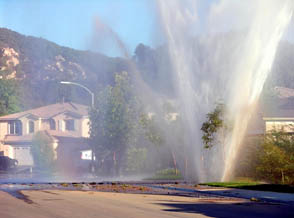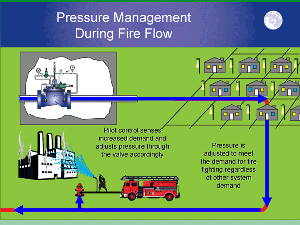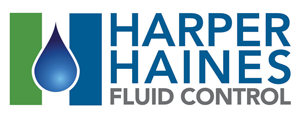Harper International (dissolved 2012): Article_7228-2: pressure management
Reduce Water Pressure to Save Water and Energy Without Compromising Fire Flow
Regarding pressure in Water systems, managers know that lower pressure systems are easier to manage than higher pressure systems. Typically, lower pressure systems have lower operating costs. They also use less energy to produce and pump water, spend less repairing pipe breaks, and lose less water through leaks large and small.
If it’s so simple, why don’t systems just reduce pressures as low as practically possible? Two reasons: fire safety and customer experience.
According to Fred Haines at Harper International, now there’s a way to reduce pressures at night while customers are sleeping and still make sure that normal peak and fire flow pressures will kick in automatically as these events occur.
Harper is demonstrating a new and advanced pressure management control valve from Cla-Val, which automatically lowers the outlet pressure during a low demand period in the water system. When the demand increases, the valve automatically increases the outlet pressure. This allows you to reduce costly system leakage losses (non-revenue water) and line breaks at night, when normally water pressure is higher during very low system demand.
Costs of Preventable Water Leakage
Every day untold thousands of gallons of non-revenue water are lost between the source and the customer’s meter through major system breaks and small cracks in underground distribution pipelines.
 High water pressure due to low system demand – especially at night – is a significant cause of non-revenue water loss and associated expenses.
High water pressure due to low system demand – especially at night – is a significant cause of non-revenue water loss and associated expenses.
Aging pipelines, joints, flanges and shifting ground all contribute to unseen and unmeasured water loss. High pressure forces water through existing cracks and fissures in the system. Background leakage and unreported breaks continue for years, forcing the system to produce and pump more water than necessary.
High pressure is also the leading contributor to pipe breaks. Major pipe breaks are normally repaired quickly, to prevent major water loss. But breaks are costly. In the Northeast, repairing the typical pipe break can cost anywhere from $15,000 to $75,000, and many systems experience one or more pipe breaks per month.
Managers have often wished to reduce water pressures to control these costs. Reduced pressure forces less water through the system’s cracks and fissures. When pressure is reduced, pipe breaks occur less often.
Why Systems Keep Pressures High at Night
In the past, water systems had good reasons for maintaining high pressures at night.
Before Cla-Val’s pressure management valve, water systems did not have a reliable way to reduce pressures during the wee hours when demand falls. Even if timers could be set to reduce pressures between 11 pm and 5 am, systems rightly worried about unexpected demand changes, such as fire flow.
Smart system managers naturally place fire safety and customer satisfaction above water and energy conservation.
Safe, Advanced Pressure Management
Cla-Val’s advanced pressure management control valve is fully adjustable and was developed specifically to solve this problem. It automatically changes outlet pressure from a high setting during high flow conditions to a low setting during low flow conditions.
The device’s all-hydraulic operation assures smooth ramping between pressure settings, so that pressure change is invisible to the customer. Cla-Val also offers electronically actuated pressure reducing control valves for remote control functionality.
Advanced pressure management pilot system controls can be retrofitted to existing, installed Cla-Val control valves. Systems can use valve flow measurement along with pressure management to identify areas where immediate improvements can be made.
“We suggest water systems prove it to themselves with metered trials,” says Haines. Harper helps water systems identify locations with good potential for cost-saving pressure management. After a few weeks of experience, the system can calculate the annual water and energy savings of adding pressure management throughout its plant.
“Every water system is unique,” says Haines, “and there are many factors in non-revenue water loss. However, we anticipate that advanced pressure management can deliver appreciable savings in the cost to produce and pump water. Fewer pipe breaks also add to the savings.”
Harper International believes that the cost of retrofitting a system with pressure management valves is easily recoverable. “The payoff is under two years when you consider preventing pipe breaks,” says Haines.
Fire Safety
Water systems never want to be in a position where there’s not enough water to fight a fire.
 As shown in this diagram, Cla-Val’s pressure management valve responds quickly during fire flow.
As shown in this diagram, Cla-Val’s pressure management valve responds quickly during fire flow.
The pilot control senses increased demand and adjusts pressure through the valve accordingly. The system pressure is elevated to meet the demand for fire fighting.
Cla-Val’s pressure management valve can also allow the water system to raise water pressures above “peak” daytime pressures to fight fires. The greater the fire flow, the higher the system losses to be overcome by this increased flow.
Customer Satisfaction
No water system needs complaints about low water pressures at family bath-time. The secret is careful implementation.
Haines recommends gradually reducing pressures under low-demand conditions so that the change is imperceptible to the customer. Similarly, the water system can start with a narrow pressure range, say five to seven PSI, and gradually widen it.
For More Information
See a demonstration of Cla-Val’s new pressure management solutions by contacting Fred Haines. Or visit the Cla-Val website.
125 Old Gate Lane, Milford, CT 06460
Telephone: 203.693.3740 * Fax: 203.547.6092


